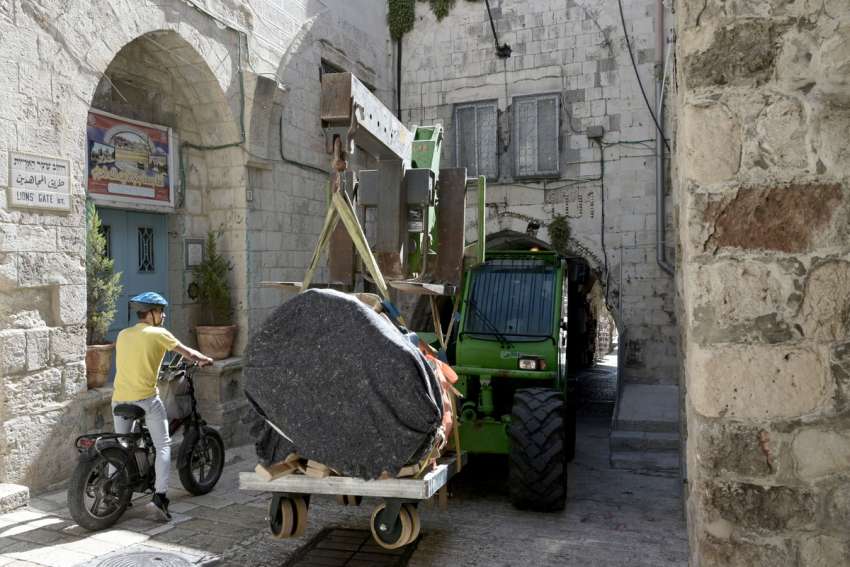JERUSALEM -- One of Israel’s leading archeologists working on the Pilgrimage Road excavation near Jerusalem’s Temple Mount said that with so much new construction underway around the Holy City the rush is on to document and preserve the past before it’s too late.
“Right now in Jerusalem we have about 14 excavations running — and we have 30,000 registered antiquity sites in all of Israel,” said Yehiel Zelinger, a Jerusalem Region archeologist for the Israel Antiquities Authority.
“There is so much construction and development we have to catch as much as we can right now because otherwise we won’t have the data.”
One of the major projects getting a lot of attention over the last decade is the discovery of what is believed to be a 2,000-year-old pilgrim walking path, or stepped street, in Jerusalem’s City of David National Park area. It connects the Pool of Siloam in east Jerusalem to the foot of the Temple Mount, at the site of the holiest site in Judaism and one of the holy places for Muslims as well. The Temple Mount with its Dome of the Rock and the nearby Al-Aqsa Mosque is considered the third holiest site in Islam.
The Pilgrimage Road excavation project is being funded by a number of private donors and is expected to be open to the public in the coming two years.
The tunnel excavation of the Pilgrimage Road, which is now running through a tunnel underneath a number of local homes, is believed to have served as a pathway to the Temple Mount used heavily during the main pilgrimage festivals during the reign of Herod the Great. The road therefore was likely familiar to Jesus as well as the millions of Jewish pilgrims here during their ascent to the Temple.
The Pool of Siloam, which is likely hundreds of years older than the Pilgrimage Road, also is the site where the Gospel of John records Christ healing a blind man.
Zelinger said if he had his druthers he would prefer to leave any archeological site undisturbed and for future generations who may have better scientific methods for preserving and analyzing soil and excavated artifacts. But construction projects including that of a future parking garage nearby — and which partially led to the discovery of the Pilgrimage Road — means that Israel’s antiquities department has had to step in to document and preserve what historic finds they can before construction can proceed.
There are currently some 80 archeologists all over Jerusalem district at work in the area. As with any dig, some of the most revealing objects uncovered include coins, pottery, cookware and jewelry, and that has been the case at the Pilgrimage Road excavation as well.
It is believed a community market space was part of the walkway experience, while archeologists are still speculating on the exact purpose of other structures of the excavation they have uncovered.
The street was approximately eight metrres wide and its length from the Pool to the Temple Mount is 600 metres. The pathway was constructed with gutters to allow water to drain down to a well-defined drainage system immediately below the stepped street.
“The main thing we are using (for understanding an excavation site) is pottery: it is the cheapest thing and from all throughout the years — 4,000 years ago people cooked in vessels and cooking pots and 500 years ago and 200 years ago — each cooking pot looked a little bit different,” Zelinger said.
“In classical periods we also have coins to give us a clue of the phase we are dealing with.
“The biggest problem in archaeology is that you can excavate a site just once, because when you are actually excavating it you ruin the site; and if you are not doing the documentation well, you lose the data. So the most important thing is the documentation and publishing the date.”
Some additional 100 metres of the Pilgrimage Road remain to be excavated before tourists can visit and walk along the full length of the route, following in the footsteps of ancient pilgrims to the Holy City.
Meanwhile the nearby City of David National Park and Davidson Center Archaeological Park provide private guided tours here. Currently, academics have reportedly debated whether the Pool of Siloam was a mikveh for ritual purification before walking up the street to the Temple or simply a Roman recreational facility.
“The most important thing is to publish (findings) for the scientific community and for the public,” said Zelinger, who also teaches archeology at a local university. “It has to be built on facts and once more we are trying to work with facts — coins, poetry, carbon footing, magnetic fields — all those things are methods that build up the story.”
That historical story also can be augmented with sacred Scripture and historical written sources but usually only after all the scientific processes have been exhausted, Zelinger added.


